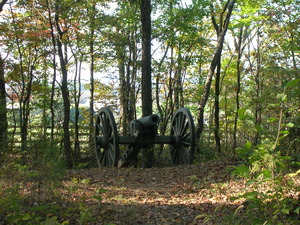Imagine yourself in the brand new uniform of a Union or Confederate soldier during the American Civil War. You’ve just enlisted to fight in a conflict that many of your fellow townspeople think will only last a matter of weeks or months before you’ve won and return home, heralded as a hero.
Unfortunately the glamor of enlistment will not last. The shine of your brass buttons on that woolen uniform coat will fade, the cheers of your family, friends, and neighbors as you march out of town with your company will disappear into the background, leaving them only to be heard in your memory.
Even more sadly, these fond memories will be replaced with the sound of gunfire, the rattle of wagons and the hoof beat of horses, the echo of the artillery and the shrill and sometimes harsh yell of your commanding officer as you are led into battle.
The gunfire, the clouds of smoke that roll over the field of battle in a dense fog, enveloping everything within your sight. You see your friend or the dearest family member wounded by a gunshot or the explosion of an artillery shell. People that you knew from your life outside of the army, people who you grew up with, worked with, and lived next to. Now they are falling all around you, and all of a sudden, you find yourself wounded.
You fall to the ground and look up as you see your fellow soldiers being led on by their captain through the storm of gunfire and the shouts of men. Maybe you will lay there on the ground for many hours, waiting and hoping for the medical corps to come. Then as you look up again, in a daze caused by being wounded, you see two men approaching you, they are wearing the uniform of the medical corps, they are the stretcher bearers. They are here to evacuate you back behind the safety of your own lines and to the field hospital that awaits you and so many others, both your fellow soldiers and even some of your enemies, for the field hospital is neutral ground in the laws and articles of war.
This is where the real story begins, in the field hospital. Staffed by medical doctors, surgeons, and the medical staff, this is where we begin our survey of medical care and technology during the American Civil War.
Weaponry at this point in history was advancing a mile a minute. Rifles were replacing muskets, revolvers were replacing single-shot pistols, artillery was becoming more accurate, longer ranged, and deadly.
Sadly, medical technology at this time was still primitive at best. Infantry tactics were also becoming more and more outdated with each new invention and passing day. Most of the tactics taught in military schools of the time such as West Point and the Virginia Military Institute were based and replicated from the same military drill and battlefield tactics that Napoleon had mastered many decades before. This left the officers with no choice but to face off and battle in tight columns of men, marching and sometimes charging straight forward into enemy gunfire and artillery. In the days of Napoleon this was still dangerous but involved less risk because of the inaccuracy of the weaponry in that age, but now in the times of the American Civil War, muskets were being replaced with rifles. Rifles had a far longer range of accuracy, they fired a projectile in the shape of a modern bullet instead of a musket ball, and they often splintered the bone if they hit a soldier.
This made it nearly impossible for surgeons to consider anything but amputation when a soldier got wounded in an arm or a leg. If he was wounded in a more serious location such as the chest or stomach area, the wound would be labeled as fatal. There really wasn’t much that the surgeons or hospital staff could do at this time for a wound such as this. The best that could be done was to make the soldier as comfortable as possible.
Contrary to popular belief, surgeons of the time did have access to sedatives which they would utilize to sedate the patient before conducting surgery. Two common practices were used. The first practice was to use only sedation while the second practice was to give the patient a ration of rum, whiskey, or another type of strong alcoholic drink before the operation and sedation. In theory, this would help the patient to relax before the surgery and sedation began.
Typically the Union field hospitals had access to better equipment and better medicines than the Confederacy did during the war. The Confederacy had to acquire medical instruments and supplies through the Union blockade of the seacoast while the Union was able to procure medical supplies more easily and quickly. Sometimes the Confederate surgeons would even be forced, due to a lack of supplies, to resort to using natural and herbal remedies in place of proper medicine.
The experience and knowledge of surgeons on both sides of the conflict varied greatly from one hospital to another. Some surgeons had studied medicine longer and had more practice while others had only been practicing for a matter of months. There was a high demand during the Civil War for surgeons and many would enlist for the job with limited and questionable experience and skill.
Germs, bacteria, and infection were virtually unknown at this time also. The field hospitals and larger general hospitals did not practice proper sanitary practices and neither did the surgeons or medical staff.
During the American Civil War there were far more deaths from disease than the battlefield. Many illnesses were contracted by the soldiers when they entered the close quarters of a winter encampment or even at basic training when they first enlisted. Many of these men lived in the country or a more isolated setting. Being around so many other people would introduce them and make them susceptible to many diseases.
On the brighter side, medical practices during the war were actually advancing and could even be called the dawn of a new era. A sanitary commission would be formed on the Union side and many Confederate surgeons started to take more interest in proper sanitation. Also, soldiers who went home after the war would start to desire more professional medical practice, and the surgeons would start to learn that improved sanitation practices led to a higher survival rate of the patients that they were treating. The Civil War also saw the implementation of a highly skilled ambulance corps that would be continued after the war when the soldiers returned to their hometowns and cities of origin. The era also saw a greater and wider interest in procuring prosthetic limbs for amputees.
We are now within the sesquicentennial of the American Civil War. This 150th anniversary marks a great time in our history when we should be honoring those men who gave their lives for freedom and sacrificed all for a cause that they believed in. These men and soldiers are our for bearers and they are a noble set of individuals whom we should take great pride in remembering and honoring.
No matter when your family came to America, one thing is for sure, we can all find common ground in remembering these soldiers and war heroes who fought for our freedoms and we can see the legacy that they have left us. Advances in medical technology during the war was a great step taken towards the advancement of medicine and the professional practices that have been put in use in the medical field of today.


